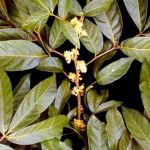| Common Name: |
Marapuama |
| Other Names: |
Muira Puama, Potency Wood |
| Botanical Name: |
Ptychopetalum olacoides |
| Genus: |
Ptychopetalum |
| Family: |
Olacaceae |
| Native Location: |
Amazonian Columbia, Venezuela, Peru, Brazil |
| Cultivation: |
Moist soil in shade. This species does not appear to be in cultivation. |
| Harvest: |
Roots, bark, wood, and balsam are collected for liquid extracts. |
| Height: |
5-15m (15-50ft) |
| :Width |
3-5m (10-15ft) |
| Hardiness: |
Min. 15-18°C (60-65°F) |
| Parts Used: |
Roots, bark, wood, balsam |
| Properties: |
A spicy, warming astringent herb that has aphrodisiac and stimulant effects, probably acting mainly on kidney energy. |
| Medicinal Uses: |
Internally for impotence, infertility, paralysis and other central nervous system disorders, menstrual problems, rheumatism, and dysentery. |
| Bibliography: |
Encylopedia of Herbs by Deni Brown Copyright ©: 1995, 2001 Dorling Kindersley Limited pp 335-336
|

